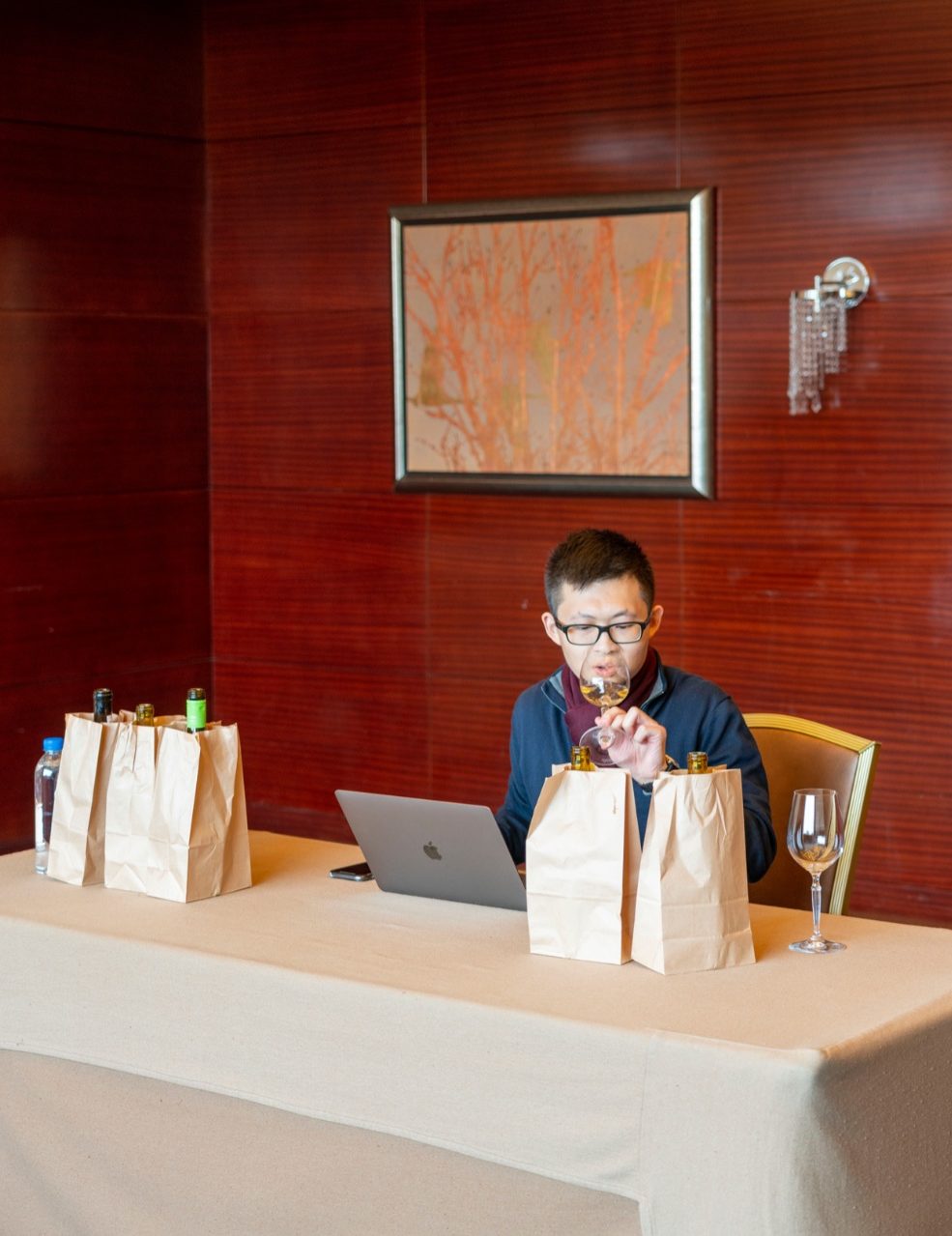中国酒业新闻网·华夏酒报-酒类产业链首席门户

China’s wine scene has moved on rapidly in the last few years. This Silver Heights vineyard in the city of Yinchuan is now a wine culture center. The vines are already buried in the soil by mid-November. Photo by Wu Xingwei.
Located in the central northwest of China, Ningxia Hui Autonomous Region has been developing its wine industry with “China speed”. Only five or six years ago there were far fewer wineries in operation, and those that were making wines were still learning the intricacies of producing quality wines.
Today the number of wineries in Ningxia, which is 1,000 kilometers from Beijing and situated on an open plateau 1,000 meters above sea level, has mushroomed to nearly 100, and there are at least another 100 waiting for government approval to start producing wines. Some are modest, some lavish, some bizarrely western, and some ingeniously modern and unique. And they are no longer a glamorous facade – the wine that comes out of many of these wineries is now the real deal. Yes there are still some problems with formula winemaking, but the road to great wine has been paved.
This is our first close-up review on Ningxia, which features around 130 wines from the region, including a few tasted in the wineries: Helan Qingxue, Domaine des Aromes, Legacy Peak, Lilan Winery, Chateau Mihope, Xige Estate and Silver Heights.

Zekun Shuai, associate editor d in Beijing, tastes 130 samples from Ningxia for this report.
Most producers sent samples on request (including a few purchased samples) as their wines were already on our radar. The results delivered just a few disappointments despite a relatively high number of corked wines – six bottles in total. Considering that almost one-third of the wines now use DIAM corks, that cork taint rate is very high, and this is a noticeable issue here. Winemaker Gu Jiawei from the Ruwen winery explained that the natural corks exported to China from Portugal and Spain often turn out to be their lower-quality closures, which is why many serious producers have turned to DIAM corks over the last few years. Ruwen is now experimenting with different stoppers, including one made of bamboo that also blocks TCA.
Of the 130 samples tasted, many found a comfort zone within a range of 88-90 points, but only 13 wines made it to 93 points or above. These were wines with real character instead of just being flattering and generous (especially in sweetness), which is a commonly found quality from the reds in Ningxia.
Some would say the “sweet fruit” is what Ningxia red wine is about, which has to do with the climate and terroir. Certainly, the climate gives a rich, fruity context to varietals like cabernet and merlot, but I couldn’t help wondering if this was also just an excuse for not trying hard enough or for picking late to fit the expectations of the market, something that will have an even bigger impact on the style than terroir and climate. After all, the top wines in this report have little problem with that cloying character. Nevertheless, after tasting 130 wines Ningxia has lived up to the expectations given the numerous medals the region receives year after year. But there is still a lot of work to do if wineries want to be rigorous and unremitting with quality, and aspire for more in the future.
NINGXIA’S RICH, GENEROUS RED STYLE DOTTED WITH NEW DISCOVERIESToday, Ningxia makes solid, rich, yet heady reds with that “flattering” sweetness. Undoubtedly, the fruit generosity enhanced by a supple mouthfeel thanks to high alcohol (some over 15.5%) and glycerol is very New World-like, and some also left a bit of residual sugar around 4-5g/L to make it even more appealing to the inexperienced, new consumers. As cabernet sauvignon struggles to ripen here (when it does, without going overripe, it makes beautiful wines), many producers started to harvest late to make sure the wine does not have an unpleasantly lifted bell-pepper character, something common 10 years ago. “Most Chinese consumers don’t like acidity and tannin” was a common comment when I spoke to producers, and being Chinese myself, I know this is the case for most consumers who just started drinking wine.
热门曲谱
 渡情笛子曲谱
渡情笛子曲谱 曲谱自学网今天精心准备的曲谱是《渡情笛子曲谱》,下面是详解!
竹笛 我想学 渡情 请问是买A还是B调 的笛子 我还要...
竹笛的调和...
[详情]分类:曲谱大全时间:07:36 c调口琴曲谱
c调口琴曲谱 曲谱自学网今天精心准备的曲谱是《c调口琴曲谱》,下面是详解!
求c调24孔口琴简谱大全
小弟求c调24孔口琴简谱大全,邮箱:zifuchen@st...
[详情]分类:曲谱大全时间:07:36 徳德玛歌曲谱
徳德玛歌曲谱 曲谱自学网今天精心准备的曲谱是《徳德玛歌曲谱》,下面是详解!
德德玛歌曲
1. 草原母亲河
[详情]分类:曲谱大全时间:07:36
2. 蓝蓝的马莲花
3. 阿妈的... 京剧青衣曲谱
京剧青衣曲谱 曲谱自学网今天精心准备的曲谱是《京剧青衣曲谱》,下面是详解!
京剧老旦唱段曲谱 与琴谱有什么区别
两者均属旦行。旦行包括:青...
[详情]分类:曲谱大全时间:07:35 诺言钢琴曲谱
诺言钢琴曲谱 曲谱自学网今天精心准备的曲谱是《诺言钢琴曲谱》,下面是详解!
洛洛历险记的片尾曲诺言的钢琴简谱(最好有前奏)
偶然听见这首歌觉得...
[详情]分类:曲谱大全时间:07:34 流行口琴曲谱
流行口琴曲谱 曲谱自学网今天精心准备的曲谱是《流行口琴曲谱》,下面是详解!
适合初学者的口琴简谱,要流行音乐的
我把爱铺成蓝天 ...
[详情]分类:曲谱大全时间:07:35 又见山里红曲谱
又见山里红曲谱 曲谱自学网今天精心准备的曲谱是《又见山里红曲谱》,下面是详解!
又见山里红简谱
分类:曲谱大全时间:07:31 钢琴流行曲谱
钢琴流行曲谱 曲谱自学网今天精心准备的曲谱是《钢琴流行曲谱》,下面是详解!
有没有流行歌曲的钢琴简谱
樱花草,老人与海,爱转角等。谢谢。本人急...
[详情]分类:曲谱大全时间:07:29 古筝乡韵曲谱
古筝乡韵曲谱 曲谱自学网今天精心准备的曲谱是《古筝乡韵曲谱》,下面是详解!
古筝 乡韵
乡韵多难?既然云裳诉是它改的,乡韵应该也很难吧,特长生...
[详情]分类:曲谱大全时间:07:27 初学古琴曲谱
初学古琴曲谱 曲谱自学网今天精心准备的曲谱是《初学古琴曲谱》,下面是详解!
请问初学者如何识古琴谱,对谱怎么弹?
减字谱:
[详情]分类:曲谱大全时间:07:27
识谱还是比... 一生无悔曲谱
一生无悔曲谱 曲谱自学网今天精心准备的曲谱是《一生无悔曲谱》,下面是详解!
基督教歌曲为福音一生无悔谱
基督教歌曲为福音一生无悔谱...
...[详情]分类:曲谱大全时间:07:26 手机曲谱软件
手机曲谱软件 曲谱自学网今天精心准备的曲谱是《手机曲谱软件》,下面是详解!
在手机上怎么制作谱子
没试过用手机做谱子,效率太低了…
[详情]分类:曲谱大全时间:07:22
建... 渴望主题曲谱
渴望主题曲谱 曲谱自学网今天精心准备的曲谱是《渴望主题曲谱》,下面是详解!
渴望的简谱
《渴望》的简谱是电视剧《渴望》录制的同名主题曲...
[详情]分类:曲谱大全时间:07:22 乐伶曲谱在哪
乐伶曲谱在哪 曲谱自学网今天精心准备的曲谱是《乐伶曲谱在哪》,下面是详解!
天涯明月刀ol乐伶曲谱怎么获得
首先你要学会第一职业 第二行里面...
[详情]分类:曲谱大全时间:07:21 天刀童话曲谱
天刀童话曲谱 曲谱自学网今天精心准备的曲谱是《天刀童话曲谱》,下面是详解!
天涯明月刀ol文士曲谱有哪些
笛曲·水云游 由身份技能点...
[详情]分类:曲谱大全时间:07:20 天刀曲谱弹琴
天刀曲谱弹琴 曲谱自学网今天精心准备的曲谱是《天刀曲谱弹琴》,下面是详解!
天涯明月刀乐伶怎么弹琴给别人加BUF
1:要想加BUF,首先游戏中...
[详情]分类:曲谱大全时间:07:20 天竺少女曲谱
天竺少女曲谱 曲谱自学网今天精心准备的曲谱是《天竺少女曲谱》,下面是详解!
天竺少女的古筝谱
分类:曲谱大全时间:07:18 绿岛小夜曲曲谱
绿岛小夜曲曲谱 曲谱自学网今天精心准备的曲谱是《绿岛小夜曲曲谱》,下面是详解!
绿岛小夜曲原唱晋秦歌词和谱曲
绿岛小夜曲原唱晋秦歌词和谱曲...[详情]
分类:曲谱大全时间:07:17 越剧曲谱下载
越剧曲谱下载 曲谱自学网今天精心准备的曲谱是《越剧曲谱下载》,下面是详解!
求越剧简谱
吴凤花的《狸猫换太子》拷寇部分,三次举起无情棒的曲谱,...
[详情]分类:曲谱大全时间:07:13 萨克斯曲谱简谱
萨克斯曲谱简谱 曲谱自学网今天精心准备的曲谱是《萨克斯曲谱简谱》,下面是详解!
学萨克斯要学五线谱还是简谱
学萨克斯必须学五线谱。
[详情]分类:曲谱大全时间:07:37
其实...
